Calibration of Stratified Random Sampling with Combined Ratio Estimators
Jamiu Olasunkanmi Muili1*  , Ran Vijay Kumar Singh1
, Ran Vijay Kumar Singh1  , Gerald Ikechukwu Onwuka1 and Ahmed Audu2
, Gerald Ikechukwu Onwuka1 and Ahmed Audu2 
1Department of Mathematics, Kebbi State University of Science and Technology, Aliero, Nigeria .
2Department of Statistics, Usmanu Danfodiyo University, Sokoto, Nigeria .
Corresponding author Email: jamiunice@yahoo.com
DOI: http://dx.doi.org/10.13005/OJPS07.01.05
This study considered modification of combined ratio type calibration estimators in stratified random sampling using calibration estimation approaches. The estimators of population mean in stratified random sampling depends on the strata estimated sample means. However, the means are sensitive to the extreme values or outliers in the sample observations of the study variables and strata sizes respectively. A new sets of calibration weights and property of the suggested combined calibration estimators of population mean in stratified sampling were derived. Empirical study through simulation was conducted to investigate the efficiency of the modified combined ratio-type calibration estimators of population mean obtained and the results revealed that the suggested estimators of population mean performed better than some existing estimators considered in the study.
Copy the following to cite this article:
Muili J. O, Singh R. V. K, Onwuka G. L, Audu A. Calibration of Stratified Random Sampling with Combined Ratio Estimators. Oriental Jornal of Physical Sciences 2022; 7(1). DOI:http://dx.doi.org/10.13005/OJPS07.01.05
Copy the following to cite this URL:
Muili J. O, Singh R. V. K, Onwuka G. L, Audu A. Calibration of Stratified Random Sampling with Combined Ratio Estimators. Oriental Jornal of Physical Sciences 2022; 7(1). Available from: https://bit.ly/3Anvuc7
Download article (pdf) Citation Manager Publish History
Select type of program for download
| Endnote EndNote format (Mac & Win) | |
| Reference Manager Ris format (Win only) | |
| Procite Ris format (Win only) | |
| Medlars Format | |
| RefWorks Format RefWorks format (Mac & Win) | |
| BibTex Format BibTex format (Mac & Win) |
Article Publishing History
| Received: | 2022-06-09 |
|---|---|
| Accepted: | 2022-07-28 |
| Reviewed by: | 
 Prayas Sharma
Prayas Sharma |
| Second Review by: |

 Mohammad Alqudah
Mohammad Alqudah |
| Final Approval by: | Dr. Amit Kumar Verma |
Introduction
Proper utilization of auxiliary information to obtain the efficiency of estimates of the population mean has increased in the theory of sample surveys. Many researchers have used auxiliary information in product, ratio and regression type estimators to obtain more efficient estimator under different sampling scheme. Calibration resolution is used in stratified random sampling in order to achieve optimum strata weights for precision improvement of estimates of parameters. In calibration estimation, new stratum weights are calculated to minimize a certain distance measure from the original design weights while meeting a set of auxiliary information restrictions. Deville and Sarndal1 established the approach of estimate by calibration in survey sampling in 1992. The concept is to employ auxiliary data (auxiliary information) to improve a population statistic estimate. Following Deville and Sarndal4, Singh et al.9 was the first to extend a method of calibrating to a stratified sampling design. Many other researchers have investigated calibration estimates in survey sampling design utilizing various calibration constraints. These researchers include Singh10, Tracy et al.11, Kim et al.6, Clement and Enang2, Koyuncu and Kadilar7. In stratified sampling, Rao et al.8 suggested a multivariate calibration estimator for the population mean based on different distance measures and two auxiliary variables. In the previous studied, none have considered calibration estimation in combined ratio estimators. In this study, calibration approaches have been adopted in combined ratio estimator with aim to obtain highly efficient estimators of population mean in stratified random sampling. The presence of extreme values in the observation of the study variable have no or little effect on the other estimates.
Take a look at a finite population T of N elements, T = { T1,T2,T3,…,TN} consists of L strata with Nh units in the h th stratum from which a simple random of size nh can be generated from the population using SRSWOR. Total Population size

sample size

where yhi , i = 1,2,…., Nhi and xhi ,i = 1,2,.., Nhi of auxiliary variable x and study variable y. Let Wh =Nh/ N be the weights of the strata,

the sample mean and

population mean for the study variable.
Literature Review
According to Cochran3, with stratified sampling, the classic estimator of population mean is given as:
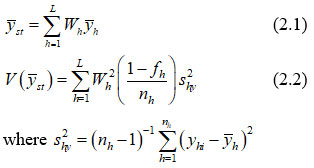
Hansen et al.5 suggested a combined ratio estimator as
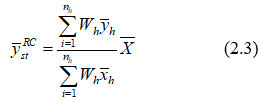
The combined ratio estimator's variance is given as follows:

Singh et al.9 presented the calibration approach for the combined general regression estimator (GREG) for the population mean given by:

By minimizing the Chi-Square distance measure, Singh et al.9 were able to get new calibration weights.

subject to the constraint

The calibrated weights and the estimator are obtained as show in (2.6) and (2.7) respectively.

As a result, the modified calibrated estimator of Singh et al.9 is:

The calibrated estimator's estimated variance is given by

where

is the hth strata sample mean square and

with

Singh10 introduced new calibration equations to a population mean calibration estimator in stratified sampling. Under stratified sampling, the Singh3 calibration estimator of the population mean Y is given by

where Ωhs is calibrated weight which is chosen so that the Chi-Square distance mean sum is:

is subject to the following constraints as a minimum
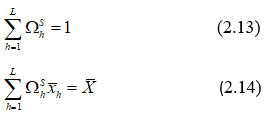
The calibrated weight and the estimator (2.11) are obtained as show in (2.15) and (2.16) respectively
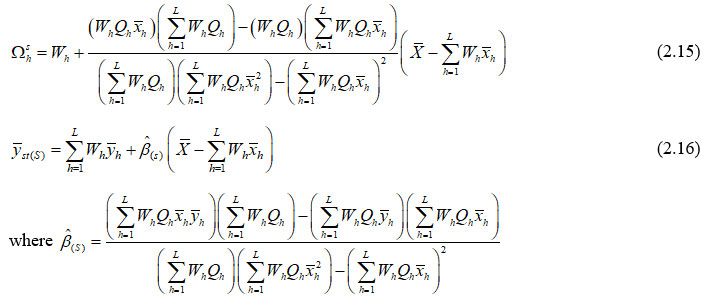
The estimated variance of Singh10 calibrated estimator is given by

where

is the mean square of the hth stratum sample while

Alam et al.1 developed a calibration estimator for estimating population mean under stratified random sampling using a distance function as follows:

where ΩhA are the calibration weights which are chosen with the distance function

where Ωhl is the hl th stratum weight which minimum subject to the calibration constraints

Minimization of (2.19) subject to the calibration constraint given in (2.20), the calibration weights are given by

And the calibrated estimator is
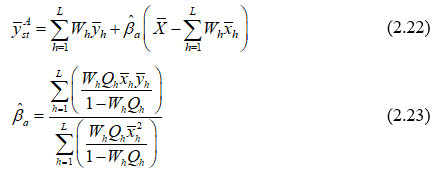
The estimated variance of Alam et al.1 calibration estimator is given by

Proposed Estimator
In stratified random sampling, the conventional Combined Ratio Estimator is given in (2.3) can be written as
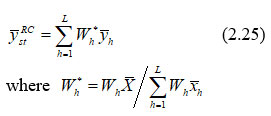
Motivated by Alam et al.1, calibrated combined ratio estimator denoted by

is modified as

where Ωh denotes the new calibrated weights that minimize the Chi-square distance.

Subject to calibration constraint given by

The Lagrange multipliers technique is employed to compute new calibrated weights (Ωh), and the following results are obtained:

Differentiating (2.29) partially in relation to Ωh, and λ, equal to zero
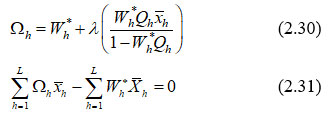
Substitute (2.30) in (2.31), the results are obtained as:

Make λ the subject of formula, obtained as:

On substituting (2.33) in (2.30) the calibrated weights can be written as:

Substituting (2.34) in (2.26), obtain the new combined calibration estimator

as:

Substituting

gives

Setting Qh = 1 and Qh = xh-1 we have the following new set of calibration combined ratio estimators respectively:
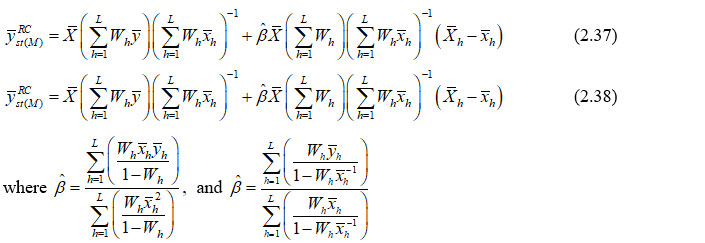
The suggested estimator's estimated variance
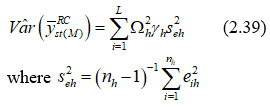
is the hth strata sample mean square and

Empirical Study Using Simulation
In this section, a simulation research was carried out to see if the proposed estimators were better than the other estimators evaluated in the study.
For this investigation, 1000-unit data was generated. Using the function defined in Table 1, populations were stratified into three non-overlapping heterogeneous groups of 200, 300, and 500. Method SRSWOR was used to randomly choose samples of sizes 20, 30, and 50 from each stratum 10,000 times. The precision (PRE) of the estimators under consideration was calculated using (2.40)

 |
Table 1: Populations Involved in the Empirical Research |
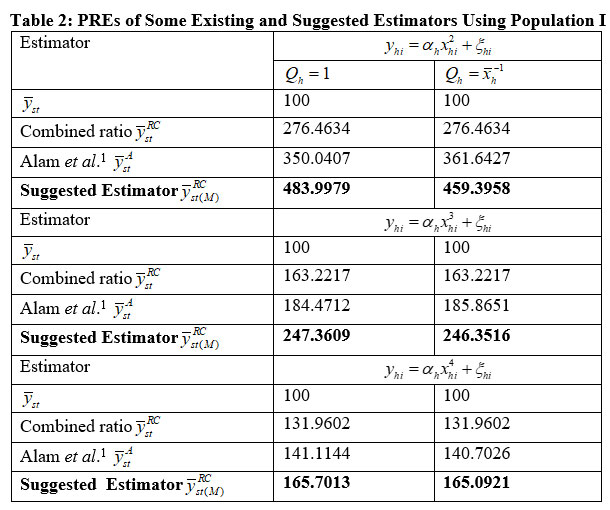 |
|
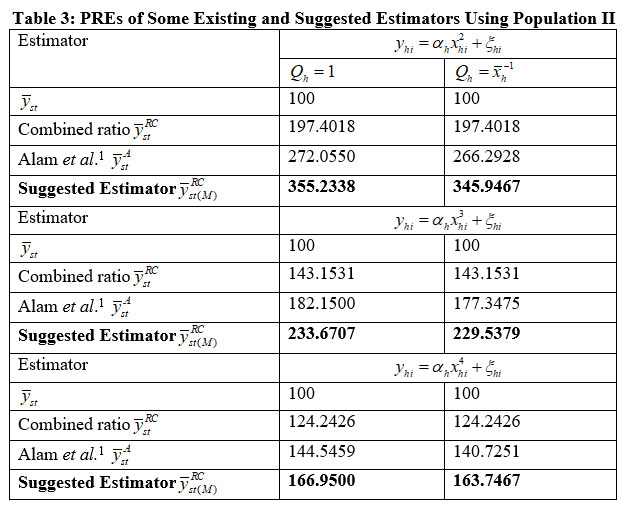 |
|
Tables 2 and 3 shown the PREs of some existing and suggested estimators considered in this study using data generated by populations I and II respectively. From the results obtained, it revealed that the suggested estimators outperformed the existing estimators considered in the study.
Conclusion
From the results obtained, the empirical study revealed that on the efficiency of the suggested calibration estimators versus the study's current related estimators, the suggested estimators have higher PREs compared to some existing calibration estimators in the numerical analysis. The suggested estimators outperformed other calibration estimators because the suggested estimators demonstrated high level of efficiency over other estimators. Hence, the suggested estimators are closers to the true values of the population mean compared to other existing calibration estimators in which the suggested estimators have more chances of producing estimates that are closer to the population mean's true value.
Acknowledgements
The authors acknowledge the Associate Editor and anonymous reviewers for their valuable work and recommendations.
Conflict of Interest
The authors declare no conflict of interest.
Funding Sources
The authors received no financial support for the research, authorship and publication of this article.
References
- Alam S., Singh S. and Shabbir, J., New Methodology of Calibration in Strati?ed Random Sampling. Survey Research Methods Section, 90 – 95, (2019). doi:10.1080/00949655.2019.1688813
- Clement E. P. and Enang E. I., Calibration Approach Alternative Ratio Estimator for Population Mean in Stratified Sampling. International Journal of Statistics and Economics, 16(1), 83-93, (2015).
- Cochran W. G., Sampling Techniques. Third Edition. John Wiley and Sons Limited. 1977.
- Deville J. C. and Särndal C. E., Calibration Estimators in Survey Sampling. J. Amer. Statist. Assoc., 87, 376–382, (1992).
- Hansen M. H., Hurwitz W. N. and Gurney M., The Problems and Methods of the Sample survey of business, Journal of the American Statistical Association, 41,173-189, (1946).
- Kim J. M. Sungur E. A. and Heo T. Y., Calibration Approach Estimators in Stratified Sampling, Statistics and Probability Letters, 77(1), 99-103, (2007). doi:10.1016/j.spl.2006.05.015
- Koyuncu N. and Kadilar C., Calibration Weighting in Stratified Random Sampling. Communications in Statistics- Simulation and Computation, 45, 2267-2275, (2016).
- Rao D., Khan M. G. M., and Khan S., Mathematical Programming on Multivariate Calibration Estimation in Stratified Sampling. World Academy of Science, Engineering and Technology International Journal of Mathematical, Computational, Physical, Electrical and Computer Engineering, 6 (12), 1623-1627, (2012).
- Singh S., Horn S., and Yu F., Estimation Variance of General Regression Estimator: Higher Level Calibration Approach. Survey Methodology. 48, 41-50, (1998).
- Singh S., Advanced Sampling Theory with Applications. Dordrecht: Kluwer Academic Publishers, 2003.
- Tracy D. S., Singh S., and Arnab R., Note on Calibration in Stratified and Double Sampling, Survey Methodology, 29, 99–104, (2003).

This work is licensed under a Creative Commons Attribution 4.0 International License.





